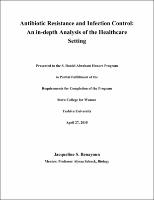Please use this identifier to cite or link to this item:
https://hdl.handle.net/20.500.12202/4094| Title: | Antibiotic Resistance and Infection Control: An indepth Analysis of the Healthcare Setting |
| Authors: | Benayoun, Jacqueline S. |
| Keywords: | Nosocomial infections --United States --Prevention. Cross infection --United States --Prevention. Infection --Prevention. Drug resistance in microorganisms --Prevention. Medical personnel --Health and hygiene --United States. Health facilities --Safety measures. Medical instruments and apparatus --Safety measures. |
| Issue Date: | Apr-2015 |
| Publisher: | Stern College for Women |
| Abstract: | Aside from illnessrelated worry and stress, hospitalized and nursing home patients have another point of concern: healthcare associated infections (HAIs). HAIs are a worldwide problem occurring in up to ten percent of hospital admissions in developed countries, and an estimated twentyfive percent in developing countries every year (World Health Organization). HAIs, or the infections that patients acquire during the timespan of receiving treatment for other conditions within a healthcare setting, have serious ramifications such as lengthening patient hospital stay, diminishing survival rate, and being extremely costly. Healthcare workers’ hands, clothing, and medical devices, namely stethoscopes and duodenoscopes, serve as vectors that transmit resistant pathogens from one patient to the next through indirect contact. Current scientific knowledge suggests that the disinfection of environmental surfaces in hospitals is indispensable although such practices are often neglected or poorly instituted. This leads to the occurrence of antibioticresistant bacterial strains, or superbugs, which develop as a result of both mutation and horizontal gene transfer. In order to diminish the occurrence of HAIs and to slow the spread of antibiotic resistant microorganisms; international, statewide, and institutional disinfection practices must be normalized and implemented immediately. Suggestions to increase better compliance include expanding the availability of alcoholbased hand rubs, requiring hospitals to launder healthcare workers’ clothing, and developing more accurate, rapid diagnostic methods for pathogen identification and treatment. It is through a combined effort that the superbug problem can be restrained before it evolves into a more severe epidemic and millions of lives can be spared from HAI related deaths. |
| Description: | The file is restricted for YU community access only. |
| URI: | https://hdl.handle.net/20.500.12202/4094 https://ezproxy.yu.edu/login?url=https://repository.yu.edu/handle/20.500.12202/4094 |
| Appears in Collections: | S. Daniel Abraham Honors Student Theses |
Files in This Item:
| File | Description | Size | Format | |
|---|---|---|---|---|
| Jacqueline-Benayoun.pdf Restricted Access | 592.66 kB | Adobe PDF |  View/Open |
This item is licensed under a Creative Commons License

